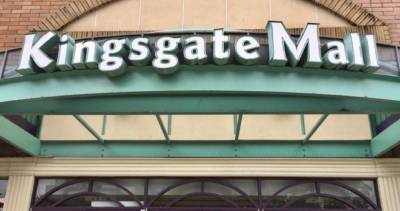Homeless in Vancouver: The ToyMac sign as seen from Hastings and Birch
So, on Sunday (July 30), someone living on West 13th Avenue, just off Birch Street, threw out a really gigantic, full-colour, photo mural of East Hastings Street in Vancouver’s Strathcona neighbourhood.
The glossy foam-core-mounted mural was maybe a metre by two metres and appeared to depict the north side of East Hastings Street at the intersection with Mclean Drive.
At least the mural showed the Waldorf Hotel sitting on the northwest corner of the intersection, as it has for the last 69 years—since 1949.
On the northeast corner of the intersection, however, the mural placed a Toys “R” Us store—theToys “R” Us store, in fact, from the 1100 block of West Broadway. This is the location with the so-called “ToyMac” sign, where the big, vertically-arranged, lightbox letters of the store’s logo do not quite cover an older, pre-existing, “BowMac” sign—a standing relic, erected in 1958, of the Bowell McLean car dealership that occupied the site from the 1950s and well into the 1970s.
At a height of 29 metres, this Bow-Mac sign was once North America’s tallest free-standing sign and, as a result, quite the conversation piece in Vancouver. (This being in the days before television had became widespread.)
What the creator or creators of this mural have done is combine two photos—one of the Waldorf Hotel taken from the East Hastings Street side and one of the Toys “R” Us store on West Broadway taken from the Birch Street side—so that the two buildings really appear to be on opposite corners of the same intersection.
Why this was done was almost certainly to compare and contrast what little remains of the two building’s tall, classic neon signs.
For better or worse, the Waldorf’s current sign appears to be a flat, plexiglass lightbox facsimile of the shapely tin-and-neon original and what’s visible of the BowMac sign is lifeless—just dull, painted tin and a lot of dead little incandescent light bulbs.
Survivors from the golden (and red, yellow and blue) age of neon
Fortunately, these two signs are not the only, or the best survivors of a time—as recently as the 1950s—when Vancouverites basked in the gaudy glow of thousands of intricate, hand-wrought neon signs.
Thanks to restoration, preservation, and good fortune, a number of much better neon signs survive—not as fossils or pale imitations but as living, blinking, working neon signage.
There are many good webpages on classic Vancouver neon signage; the Vancouver Neon Project is one that shows a lot the city’s old neon—and often with addresses but it’s not always clear on this site whether the neon referred to still exists or not.
Actually, I haven’t found one live map on the Internet showing the locations of all currently extant neon signage in the city. There should be such a map one so I’ve thrown the beginnings of one together—a quickie Google map with about 20 neon sign locations.
One sure place to find some of the best surviving neon is along Granville Street, particularly North Granville, in the so-called entertainment district.
On South Granville, however, there is the classic neon of the Stanley Theatre—beautifully restored, inside and out, as the Stanley Industrial Alliance Stage.
And once you’ve seen this jewel of South Granville, you can walk a mere six blocks, to the 1100 block of West Broadway—not all the way to East Hastings Street in Stathcona—and then gaze with wonder on what remains of the BowMac sign.
And by “wonder” I mean that you can wonder what all the fuss was about with this unsightly, I mean, historic sign.















Comments